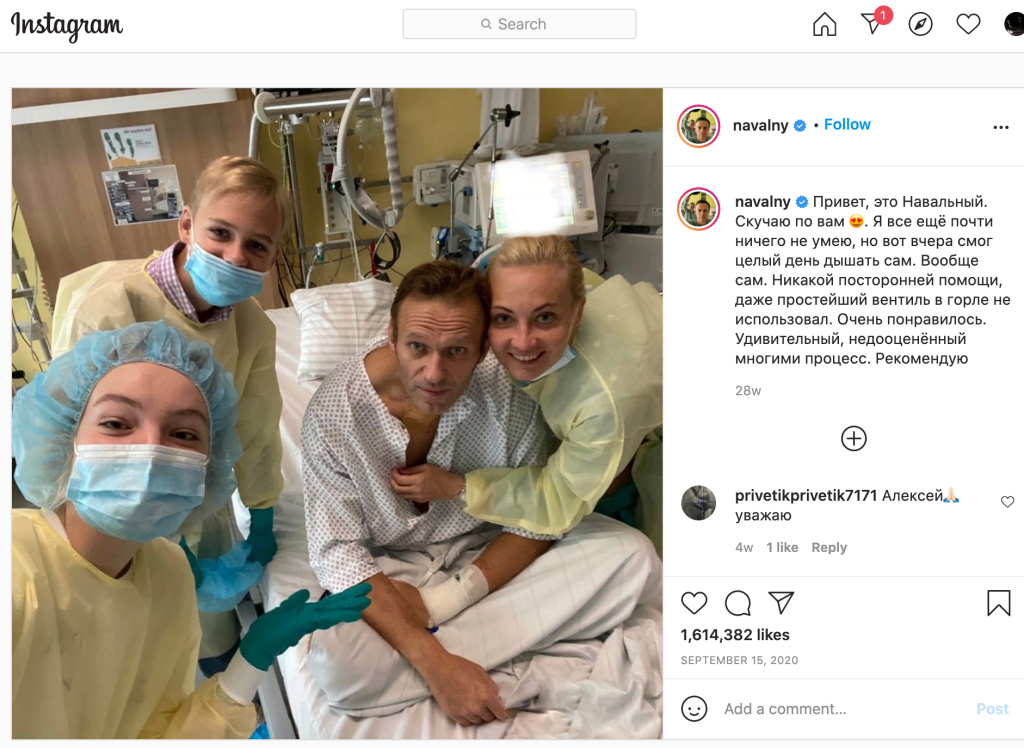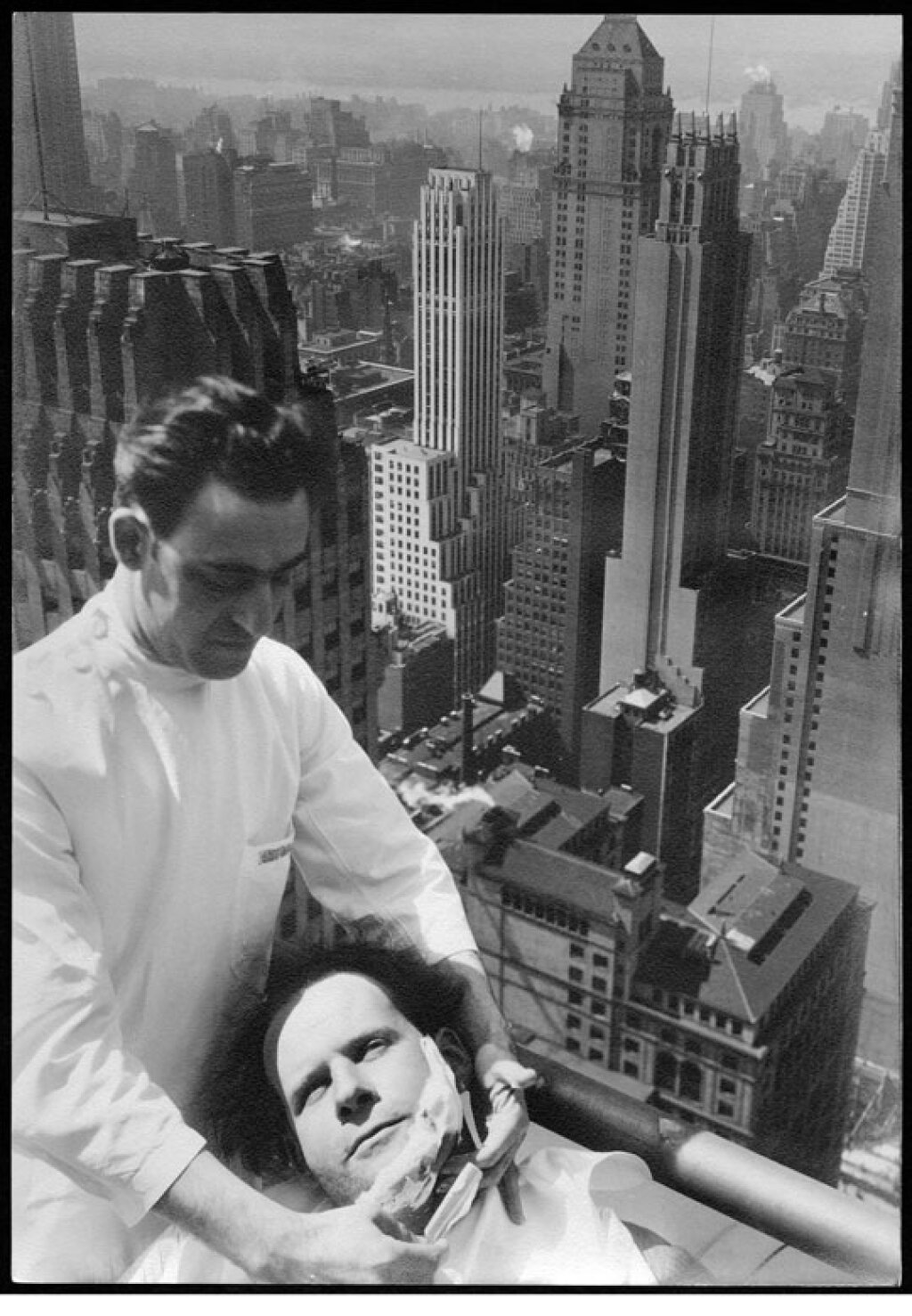Fiona Bell is a literary translator and scholar of Russian literature. Her writing has appeared in Full Stop, Asymptote Journal, The LA Review of Books, and elsewhere. She is from St. Petersburg, Florida, but currently lives in New Haven, Connecticut, where she is earning a PhD in Slavic Languages and Literatures at Yale University.
If you haven’t done so already, take a look at Alexei Navalny’s Instagram page. Besides the posts from Smart Voting and his YouTube channel, Navalny shares a lot about his personal life. Posts with his wife might as well be tagged #couplegoals. There’s other classic Instagram fare, too: waterfalls, cute animals, and fitness humblebrags. These posts never attracted my attention because so many people—even those who aren’t trying to win over the Russian public—do this kind of online image building.
It was a different Instagram post that caught my eye: Navalny’s first personal post since his poisoning. In the photo, taken at the hospital, a dazed Navalny is surrounded by his smiling family. He is hunched, his collarbone and ribs visible beneath his hospital gown. This confused man with raised brows recalls Repin’s 1884 portrait of Vsevolod Garshin, a writer who was famously depressed. Even while sitting for his friend Repin, Garshin appears viscerally alone. Navalny does, too.
I came to know Garshin—or feel that I did—in reading Allison Leigh’s 2020 book, Picturing Russia’s Men: Masculinity and Modernity in Nineteenth-Century Painting. This volume considers how male painters thought about gender from 1825-1881, a period of modernization in Russia. Each of Leigh’s subjects is damaged by some sort of unsanctioned desire: for other men, for independence, or for social upheaval. Each has a complicated relationship with institutions: the family, the state arts academy, the military, or the autocracy. Each one expresses their particular mode of brokenness in painting.
Besides Garshin, Ilia Repin also painted a portrait of Modest Mussorgsky, completed only a few days before the composer’s death in 1881 and filled with signs of his alcoholism. As physical and mental vulnerability threatens their claim to masculinity, Repin’s men are feminized and infantilized, displaying a woundedness that is symptomatic for their time. Leigh attributes it to the breakdown of masculine ideals in the late nineteenth century, especially following the public assassination of Tsar Alexander II in 1881.
As Leigh shows repeatedly in her book, ideas of masculinity are intimately connected with the state and its human emblem: the tsar. The painter Pavel Fedotov—preoccupied, in his painterly career, with his unhappy career in the army—spent the end of his life in an asylum. One of his final sketches shows the artist being examined by Tsar Nicholas I through a magnifying glass. Leigh treats this drawing at greater length in a 2019 article, reading it as a visualization of Fedotov’s claustrophobic relationship with autocracy.
But perhaps the best known painterly examination of the tsar and his victims is Repin’s 1885 historical painting, Ivan the Terrible and His Son Ivan. The canvas depicts the tsar cradling his dead son, seemingly stunned by his own capacity for violence. Noting that the face of the son is Garshin’s, Leigh suggests that this famous painting can also be read as an allegory of the autocracy’s violence against the everyman.
When I saw an echo of Garshin in Navalny’s face, Repin’s Ivan the Terrible canvas immediately came to mind. Like the nineteenth-century painter, Navalny shared an image of masculine brokenness. In so doing, he conjured the absent perpetrator of his wounds: the ruler. Now, as in Repin’s time, a wounded man is a political message.
Long before his poisoning, Navalny posed a challenge to the masculinist Russian state, his political threat often manifesting in his gender performance. When he accused the Director of the Russian National Guard, Viktor Zolotov, of corruption, Zolotov challenged him to a duel, reclaiming a nineteenth-century practice with the absurd bravado of an “ultimate fighter.” Navalny suggested that they have a debate instead, offering a vision of reasoned, liberal masculinity that contrasts with the “strongman” approach of Putin and his followers.
Because Navalny wears so many expressions—smirking maverick, adoring husband, political martyr—it’s easy to imagine his body as the victimized-yet-resilient Russian body politic. His expression of masculinity is more varied and more relatable than, say, Putin’s.
But Navalny’s versatile masculinity has its own problems and exclusions. Navalny has proven stubbornly unwilling to advocate for the freedoms of minority groups. He only resists structures of power on behalf of people “like him.” True to the liberal tradition, Navalny believes in the primacy of subjectivity. In a post following his prison sentencing, he mused that it is impossible to deprive a person of freedom when they feel free “inside.” In imagining liberation as a mental rather than a historical act, he reveals an unwillingness to examine power structures more generally — including systemic oppressions like racism or sexism.
Even as Navalny attempts to emblematize today’s precarious Russian citizenhood, his representative function is already fracturing. He leverages his injured, ethnically Russian masculinity as an accusation of the state. At the same time—and on the same social media platforms—he refuses to recognize the damage that the very same state inflicts on non-white people.
Still, the wounds persist and multiply. In recent days, Russian doctors have been calling for better medical care for the imprisoned Navalny, even as authorities suggest that he is faking his symptoms. As Leigh has shown with respect to the nineteenth century, a man’s health—and his visual projections of it—often function as political commentary. Most importantly, she reminds us that even the most articulate expressions of subjectivity exist within a historical context. Liberation must take place beyond the portrait’s frame.



